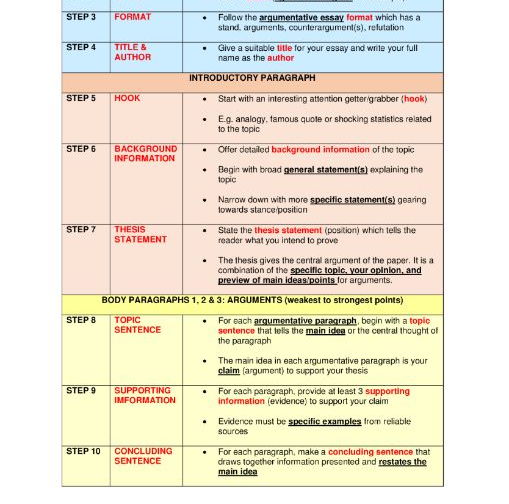
Steps to Write an Essay
· Your first sentence sets the tone for the whole essay, so spend some time on writing an effective hook. Avoid long, dense sentences—start with something clear, concise and catchy that will spark your reader’s curiosity. The hook should lead the reader into your essay, giving a sense of the topic you’re writing about and why it’s interesting · There are a few key steps in essay writing. First, you need to understand the essay topic. Then, you should brainstorm and organize your ideas. Make sure you reference your sources. Write a draft. Drafts are an excellent way to eliminate crappy ideas. Most professors will also want to see a draft. Once you have written the draft, the next step · Your writing process will be more streamlined if you start organising your sources early on. Step 3: Construct your thesis statement An essay is as good as its thesis statement. Think of your paper as building a case in a defence trial. What’s the central argument or purpose of your paper? Does it invite the reader to hear your side of the story?

Tips for fast writing like a pro
· Your first sentence sets the tone for the whole essay, so spend some time on writing an effective hook. Avoid long, dense sentences—start with something clear, concise and catchy that will spark your reader’s curiosity. The hook should lead the reader into your essay, giving a sense of the topic you’re writing about and why it’s interesting You may use this introduction and follow every step to your purpose. Step 1. Plan Your Time Think about the time you have. Make sure that it is a possible task for you. Then divide your hours into parts according to your task assignment. Make sure to leave 30 minutes, at least as a reserve · Your writing process will be more streamlined if you start organising your sources early on. Step 3: Construct your thesis statement An essay is as good as its thesis statement. Think of your paper as building a case in a defence trial. What’s the central argument or purpose of your paper? Does it invite the reader to hear your side of the story?

Mastering these steps will make your words more compelling
· Take a look at these common ways to start an essay: Share a shocking or amusing fact One way to start your essay is with a shocking, unexpected, or amusing fact about the topic you’re covering. This grabs the reader’s attention and makes them want to read further, expecting explanation, context, and/or elaboration on the fact you presented · The third step in writing an essay is to write five original sentences, at least a few of which can be descriptive. A fantastic essay has a strong theme and strong central statements. These three sentences should describe the specific topic, show the different parts of the topic and provide the principal points at a non-dense manner · Your first sentence sets the tone for the whole essay, so spend some time on writing an effective hook. Avoid long, dense sentences—start with something clear, concise and catchy that will spark your reader’s curiosity. The hook should lead the reader into your essay, giving a sense of the topic you’re writing about and why it’s interesting

Table of contents
· There are a few key steps in essay writing. First, you need to understand the essay topic. Then, you should brainstorm and organize your ideas. Make sure you reference your sources. Write a draft. Drafts are an excellent way to eliminate crappy ideas. Most professors will also want to see a draft. Once you have written the draft, the next step · Your writing process will be more streamlined if you start organising your sources early on. Step 3: Construct your thesis statement An essay is as good as its thesis statement. Think of your paper as building a case in a defence trial. What’s the central argument or purpose of your paper? Does it invite the reader to hear your side of the story? · Take a look at these common ways to start an essay: Share a shocking or amusing fact One way to start your essay is with a shocking, unexpected, or amusing fact about the topic you’re covering. This grabs the reader’s attention and makes them want to read further, expecting explanation, context, and/or elaboration on the fact you presented
Step 1: Hook your reader
· Take a look at these common ways to start an essay: Share a shocking or amusing fact One way to start your essay is with a shocking, unexpected, or amusing fact about the topic you’re covering. This grabs the reader’s attention and makes them want to read further, expecting explanation, context, and/or elaboration on the fact you presented · There are a few key steps in essay writing. First, you need to understand the essay topic. Then, you should brainstorm and organize your ideas. Make sure you reference your sources. Write a draft. Drafts are an excellent way to eliminate crappy ideas. Most professors will also want to see a draft. Once you have written the draft, the next step · Your first sentence sets the tone for the whole essay, so spend some time on writing an effective hook. Avoid long, dense sentences—start with something clear, concise and catchy that will spark your reader’s curiosity. The hook should lead the reader into your essay, giving a sense of the topic you’re writing about and why it’s interesting
No comments:
Post a Comment